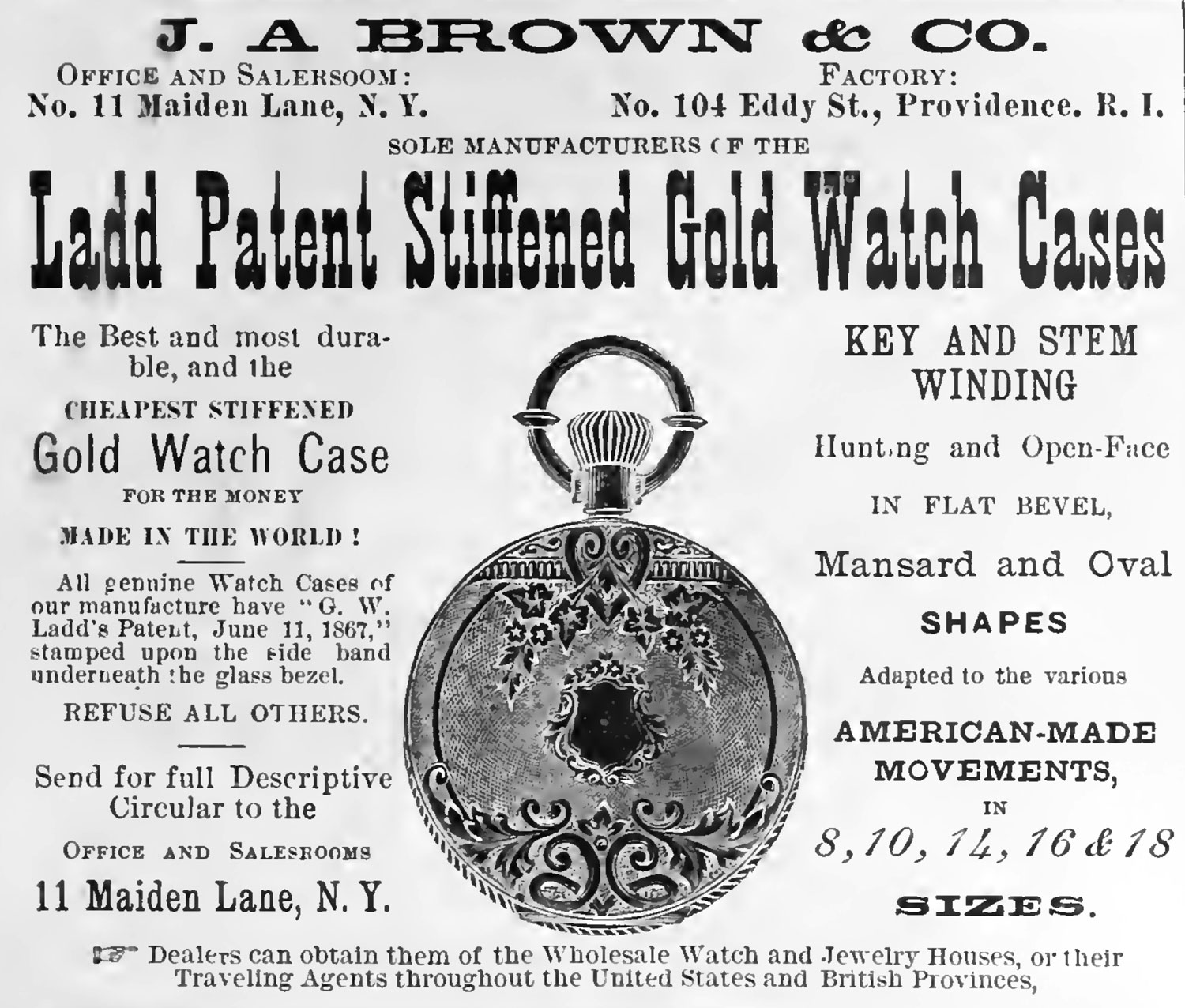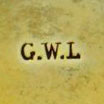Pocket Watch Database
J.A. Brown & Co. (G.W. Ladd)
Providence, Rhode Island

Initial Marking: GWL
Location: Providence, Rhode Island
Years of Operation: 1858-1883
Successor: Ladd Watch Case Co.
Firm managed by John Adams Brown. Manufacturer and Agent for George W. Ladd's Stiffened (Gold-Filled) Case. The Ladd case was introduced in 1867.
Identification: An advertisement published in an 1878 issue of The Jewelers' Circular and Horological Review states, "All genuine watch cases of our manufacture, have "G.W. Ladd's Patent, June 11th, 1867," stamped upon the side band underneath the glass bezel."
Key identification points to look for on a Ladd case are wear areas exhibited on the pendant and bow. If there is wear on the pendant but not the bow, the case may have been the "Acme" model, introduced in 1884, which featured a solid gold bow.
Ladd cases are generally only marked on the inside of the outer back cover. They are not marked on the inner cuvette nor on the inside of the front dial cover. The inside of Ladd cases are frequently characterized by splotchy patches and greenish yellow tones.
The simple thin serif serial number was marked in a small bunched format until approximately serial number 87,000, afterwhich the digits were spaced further apart in a slightly different style.
Early Ladd cases are stamped "G.W.L." with a simple serif serial number on the inside of the outer cover. Many of these cases have been found paired with movements from early runs produced by the National Watch Company (Elgin). This initialed marking style was used until approximately serial number 32,000 (c.1872).
Ladd Cases produced after c.1872 feature an embossed marks instead of the "G.W.L." marking that branded the previous generation. The style of the serial number remained consistent, characterized by small serif digits bunched together in the straight line.
One mark used was an embossed eagle symbol inside a rough octagonal shape, used on cases with serial numbers from approximately 32,000 to 44,000.
For a short period of time, an embossed anchor symbol inside an oval shape was also used. This mark appears on cases with serial numbers from approximately 50,000-60,000.
The embossed oval mark featuring a head in profile was used frequently during this era, appearing on cases with serial numbers above 60,000 (with a few observed in the 40,000 range around the transition between the eagle mark and the anchor mark.
A "Gumdrop" shaped mark of a horse head facing right was also used on a small number of cases around the 80,000-86,000 range. These were produced sequentially in the middle of cases with the profile head mark.
The highest serial number recorded is approximately 125,000. There is evidence to support that serial numbers above ~87,000 were manufactured by the Ladd Watch Case Company after 1883.
It is unclear whether these marks classified different styles of grades produced by the company or simply a progression of trade marks utilized on cases.
Some cases are not marked in these common ways and can only be identified by the "G.W. Ladd's Patent, June 11th, 1867" stamped around the dial perimeter behind the bezel.
The Ladd Watch Case Company was organized in 1883.
J.A. Brown & Co. was the exclusive manufacturer and agent for George W. Ladd's patented gold-filled watch cases.
Ladd was a member of the firm, founded in 1858 to manufacture gold plated lockets.
Ladd had been experimenting with gold stiffened watch cases since 1853. These cases, introduced to the market in 1867, were generally advertised as "stiffened gold watch cases," offering a cheaper and more durable solution to expensive solid gold watch cases.
The first year, only twenty cases were sold. However, in 1868, the number increased to 3,000.
According to reports, the J.A. Brown & Co. factory in Providence was the first copmany to employ power presses in the production of watch cases.
Around the time of the Civil War, a sales office was also established in London. The sale of lockets, pencil cases, and watch cases in Europe was a huge success.
In 1874, the factory was listed as located at 58 Eddy Street in Providence, Rhode Island, with sales offices at 11 Maiden Lane in New York.
The Ladd cases were offered in keywind and, later, stem-wind models. An advertisement published in an 1878 issue of The Jewelers' Circular and Horological Review described three distinct styles: Bascine, Flat-Bevel, and Mansard. The ad also mentioned that "more than fifty thousand" cases had been sold and that "all genuine watch cases of [their] manufacturere, have G.W. Ladd's Patent, June 11th, 1867 stamped upon the side band underneath the glass bezel."
The original Ladd gold-filled cases were described as being constructed from gold and nickel composition, providing the ability to sell the case at one-third or half the cost of similar solid gold cases.
In April 1883, J.A. Brown & Co. sold the case business, factory, and patents to the Ladd Watch Case Company. According to reports, Brown & Co. retained a large interest in the new copmany.
John Adams Brown remained the company president and treasurer until his death in 1892.
Case Grades
Note: This chart is not intended to be a comprehensive list of grades. Some grades changed traits over time and other grades may not be listed. This chart will be improved as additional information is studied.
| Image | Name | Case Material | Gold Content | Gurantee | Source Catalogs | Trademarked |
|---|---|---|---|---|---|---|
 |
Anchor | Gold-Filled | 25-Year | |||
 |
Eagle | Gold-Filled | ||||
 |
G.W.L. | Gold-Filled | ||||
 |
Head Profile | Gold-Filled | ||||
| Horse | Gold-Filled | |||||
| Ladd Patent Stiffened Gold | Gold-Filled | 1880JAB, 1880GHR, 1883GHR, 1892WES |
